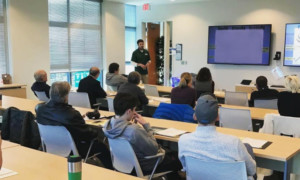 School safety remains a top priority for educators all over the country. Recently, schools in North Carolina received additional federal funding – $35 million – for enhancing safety measures. And while additional funding is certainly helpful, it isn’t the only solution for making school campuses safer. There are many strategies administrators can use to improve the safety of their campuses. Below, we’ll highlight a few common strategies that should help to keep everyone on campus safer.
School safety remains a top priority for educators all over the country. Recently, schools in North Carolina received additional federal funding – $35 million – for enhancing safety measures. And while additional funding is certainly helpful, it isn’t the only solution for making school campuses safer. There are many strategies administrators can use to improve the safety of their campuses. Below, we’ll highlight a few common strategies that should help to keep everyone on campus safer.
Emergency Preparedness
The best place to start is with emergency preparedness. Every school should have plans in place for various emergencies, whether it’s an active shooter on campus, a fire, or something else. These plans should detail what everyone is to do in those various scenarios so that no one has to wonder about what actions they should take when the situation arrives. In addition, the school should regularly perform drills to practice those emergency steps to ensure everyone knows their role.
The Latest Technologies
A great way to improve school safety is by implementing the latest technologies. There are now many tools designed to keep students safe while they’re on campus, tools that didn’t exist just a few years ago.
For example, your school could implement a tool like the Saferwatch app. According to the creator of Saferwatch, it includes tools such as “anonymous tip reporting, threat reporting, incident management, drill tracking, threat assessment, mobile panic alert system, mass notification alert system, and check-ins.” By implementing the latest emergency action tools, your school can enhance day-to-day safety and better prepare for emergencies.
Mental Health Support
One often overlooked area when it comes to improving school safety is mental health support. It’s the unfortunate reality that many school incidents arise due to poor mental health in students. To prevent these incidents from occurring in the first place, schools need resources in place to help students with their mental health.
Start by working with your school counselor to discuss current mental health services and what improvements they would like to see. Some options might include group discussion sessions, anti-bullying initiatives, or even hiring more counselors to allow for more attention to individual students.
Staff Training and Awareness
Next, schools should ensure that all staff have the proper training when it comes to emergencies and that they know the warning signs of potential problems. All staff members, including administrators, teachers, nurses, custodial staff, and aides, should receive regular training on how to handle various situations and incidents. Provide this educational training regularly throughout the year and conduct drills without the students to allow staff to practice.
In addition, help your staff improve their awareness by discussing signs they should be on the lookout for. Talk to them about how to identify students who might be in crisis and how they should handle the situation. There should also be a clear system in place for staff to report any suspicions.
Close Collaboration with Law Enforcement
Improving school safety also relies on close collaboration with local law enforcement. Local police departments should know your school’s emergency preparedness plans, as they will need to coordinate their own response plans. In addition, the police department may have suggestions on how you can improve your emergency plans based on their experience and work with other school districts.
It can also be helpful to have local officials provide presentations to your students. Have them discuss self-defense measures, how to contact local authorities, how to report an incident, and various other school safety measures. These talks will encourage a closer relationship between the students and local law enforcement while also providing valuable information.
A Positive School Environment
Finally, make sure your school is working to create a positive environment. Many school incidents occur due to unhappy students, which can be prevented through a shift in culture. Work on establishing a zero-tolerance policy when it comes to bullying and implement initiatives that encourage inclusivity and openness. When students feel safe and accepted at school, they are less likely to lash out in a dangerous manner.
Start Working Toward a Safer School Environment
Preventing all incidents within a school may be impossible, no matter how many safety policies you put into place. However, with the right strategies, you can significantly lower the odds of a dangerous event and better protect everyone on campus. By doing things like changing the school culture, preparing for incidents in advance, implementing new technologies, and collaborating with local law enforcement, you can take a major step toward improving your school’s safety in a short amount of time.


